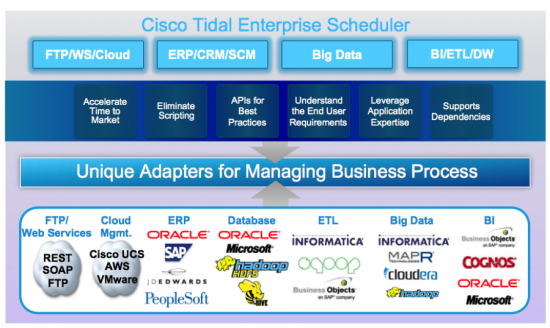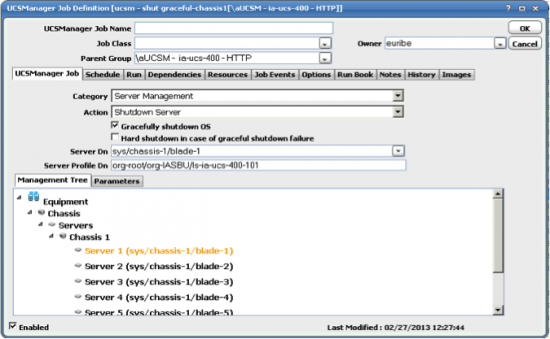Introducing New Adapter for Cisco UCS Manager, Lightweight Java Client, Multi-domain AD/LDAP Authentication & Runtime User Support for TES Workgroups
Managing and automating mission-critical business process is key to the success of your enterprise. By managing the delivery of the right data to the right application at the right time you can ensure that everyone in your organization has the information they need to be successful.
 End-to-end Workload Management with Tidal Enterprise Scheduler (TES) 6.2
End-to-end Workload Management with Tidal Enterprise Scheduler (TES) 6.2
With the release of TES 6.2, Cisco continues its leadership in workload automation (WLA) and job scheduling. With hundreds of in-production customers, running complex workloads for global trading exchanges, manufactures, health care providers and technology companies, Cisco TES has proven itself in some of the most demanding data centers in the world.
Already known and cited by analysts and customers for its ease-of-use, ease-of-installation, scalability and enterprise-wide visibility, Cisco TES 6.2 ships with major performance enhancements, added user management flexibility and greater infrastructure management reach. Enhancements in this release include:
Adapter for Cisco UCS Manager
The Enterprise Adapter for UCS Manager allows users to schedule UCS Manager component infrastructure jobs through Cisco TES so that users can leverage the scheduler’s capabilities to automate, simplify, and improve job scheduling and workload performance. The UCS Manager Adapter integrates with UCS Manager using the XML API and provides for the automation of UCS Manager activities for blade and rack-mount server management in the form of UCS Manager jobs. This allows you to control and manages server instances as part of an overall infrastructure and data processing workload management solution.
 Job Definitions for Cisco UCS Manager
Job Definitions for Cisco UCS Manager
Lightweight Java Client
For power users who are managing thousands of workloads and their associated objects in their database, the Java client syncs data directly from the Master, but it is many times faster than the client manager because all data is stored in-memory on the Java VM rather than to an external database. Many interactions through the Java client will see marked increases in performance including smooth scrolling with zero latency and faster search and filtering.
 Lightweight Java Client for TES 6.2
Lightweight Java Client for TES 6.2
Flexible Security Feature
For large enterprises that segment globally or for any user who creates domains for their data center, Cisco TES now supports multi-domain coverage from a single client manager allowing greater flexibility and ease of use. And for greater runtime flexibility, Cisco TES allows users to associate runtime users to workgroups to be used while defining the workloads.
Cisco TES and Big Data
TES supports end-to-end workloads that include Big Data business processes. This release strengthens our support for Apache Hadoop, Cloudera as well as MapR. If you are traveling to San Jose for the Hadoop Summit next week stop by our booth (Cisco is a Platinum Sponsor) to see the latest Cisco solution designed specifically for the Hadoop platform. See Scott Ciccone‘s blog post for more details.

June 3-5, 2014 –San Jose, California
Questions? ask-tes@cisco.com
For more on the TES 6.2 release visit http://www.cisco.com/go/workloadautomation
Data Center blogs I follow:
Raghunath Nambiar
Scott Ciccone
Share:


 End-to-end Workload Management with Tidal Enterprise Scheduler (TES) 6.2
End-to-end Workload Management with Tidal Enterprise Scheduler (TES) 6.2 Job Definitions for Cisco UCS Manager
Job Definitions for Cisco UCS Manager Lightweight Java Client for TES 6.2
Lightweight Java Client for TES 6.2

CONNECT WITH US